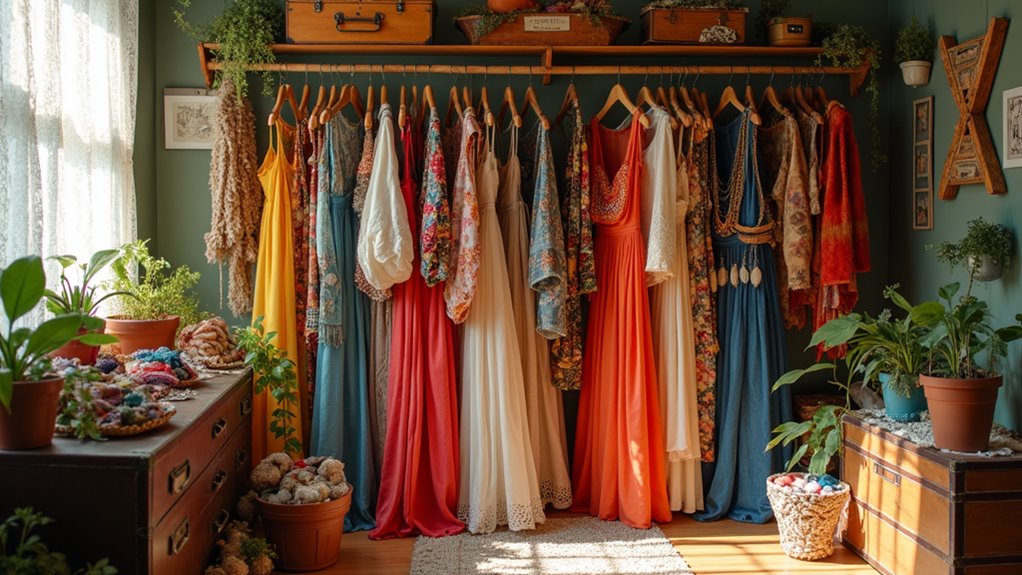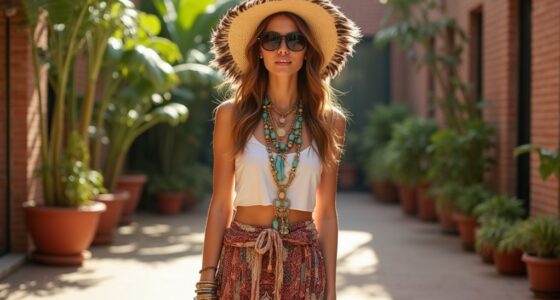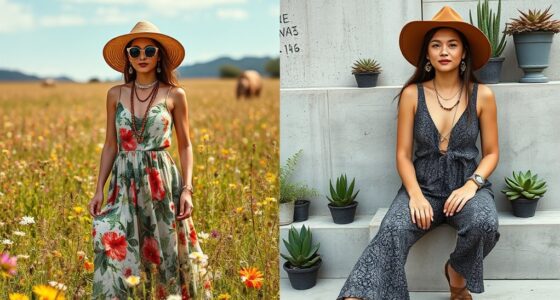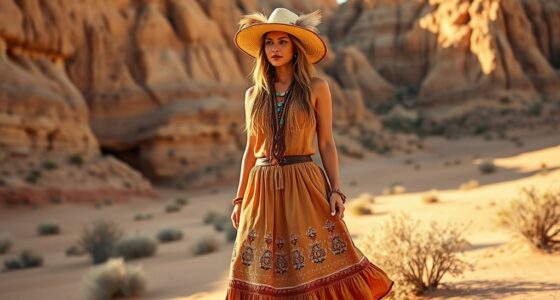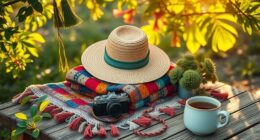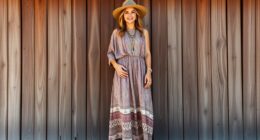Building a sustainable boho wardrobe involves choosing eco-friendly fabrics like organic cotton, hemp, and linen, while prioritizing vintage and upcycled clothing to reduce waste. Thrifting helps you find unique, durable pieces, and upcycling allows you to personalize garments with embroidery, patches, or natural dyes. Supporting eco-conscious accessories and maintaining your clothes properly extends their lifespan. If you continue exploring, you’ll discover creative ways to blend style with sustainability for a truly earthy, timeless look.
Key Takeaways
- Focus on eco-friendly fabrics like organic cotton, hemp, linen, and recycled materials to build a sustainable boho wardrobe.
- Thrift and upcycle garments to reduce waste, add personalized embellishments, and create unique, eco-conscious pieces.
- Use natural dyeing techniques and fabric scraps for DIY customization, enhancing the earthy boho aesthetic sustainably.
- Choose accessories made from reclaimed, vintage, or eco-friendly materials, and maintain them with eco-conscious care practices.
- Support brands committed to ethical sourcing, recycled fabrics, and sustainable production methods for a truly eco-friendly wardrobe.
Embracing the Boho Style With Sustainable Choices
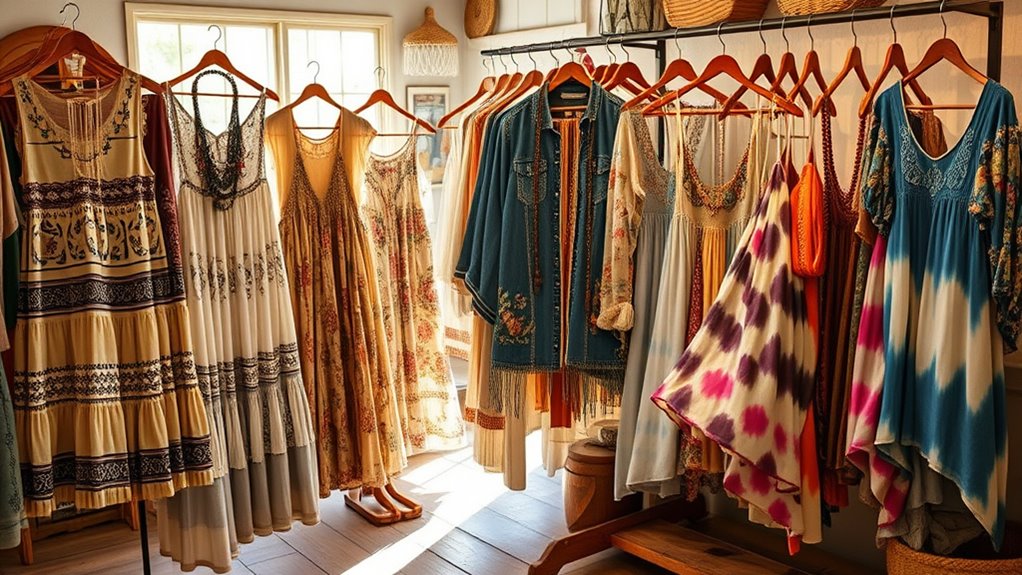
To truly embrace the boho style sustainably, you should focus on choosing eco-friendly fabrics like organic cotton, hemp, and Tencel, which lower environmental impact. These natural fibers form the foundation of sustainable boho fashion, offering comfort and style while supporting waste reduction. Incorporate vintage pieces and upcycled clothing into your wardrobe to add unique charm and promote waste reduction. Thrifting is an excellent way to discover one-of-a-kind items that align with your eco-conscious values. Personalize your garments through DIY customization, such as embroidery or dyeing, to make each piece uniquely yours. Additionally, selecting projectors with high color accuracy can enhance the visual appeal of your home cinema setup. Exploring sustainable fashion practices can further help you reduce your environmental footprint. Using ethical production methods when selecting accessories ensures that your style choices support fair labor practices and environmental stewardship. Incorporate sustainable materials like recycled fabrics or upcycled accessories to further emphasize your commitment to environmental responsibility. Choosing natural fibers such as organic cotton and hemp not only benefits the environment but also ensures comfort and durability in your wardrobe. Complete your look with natural accessories crafted from recycled or upcycled materials, emphasizing ethical production and aligning your style with environmental responsibility.
The Benefits of Thrifting and Vintage Shopping for Boho Fashion
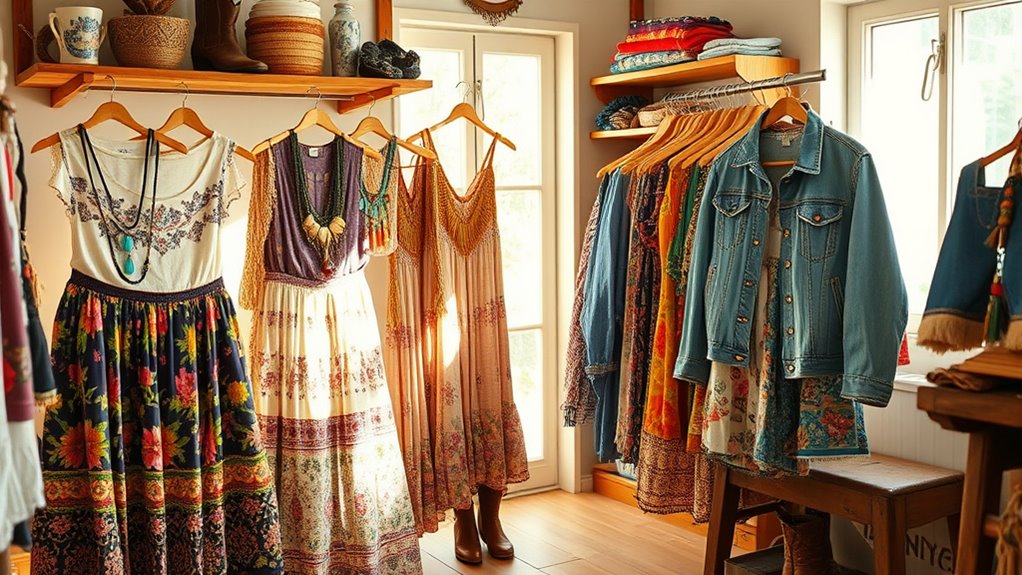
Thrifting and vintage shopping are powerful ways to enhance your boho wardrobe while staying eco-friendly. By choosing secondhand clothing, you reduce textile waste and lessen your environmental impact. Vintage shopping offers unique pieces with timeless boho style, often made from higher-quality materials than fast fashion. Supporting ethical brands through thrift stores and online resale platforms helps sustain local economies and promotes sustainable fashion. These practices enable you to craft a personalized, eco-conscious wardrobe that reflects your style. Incorporating Ethical Hacking into your fashion choices can also provide a metaphorical layer of security, ensuring your style remains uniquely yours. Additionally, incorporating Gold IRA Rollovers into your financial planning can also provide long-term security, ensuring your wardrobe investments are protected. Engaging in sustainable shopping methods can further amplify your eco-friendly wardrobe journey. Here’s a closer look: Irish dog names can also inspire your fashion choices, adding a touch of cultural uniqueness to your wardrobe. Furthermore, understanding cybersecurity principles can help you safeguard your online shopping experiences and personal data.
Upcycling Techniques to Personalize Your Boho Wardrobe
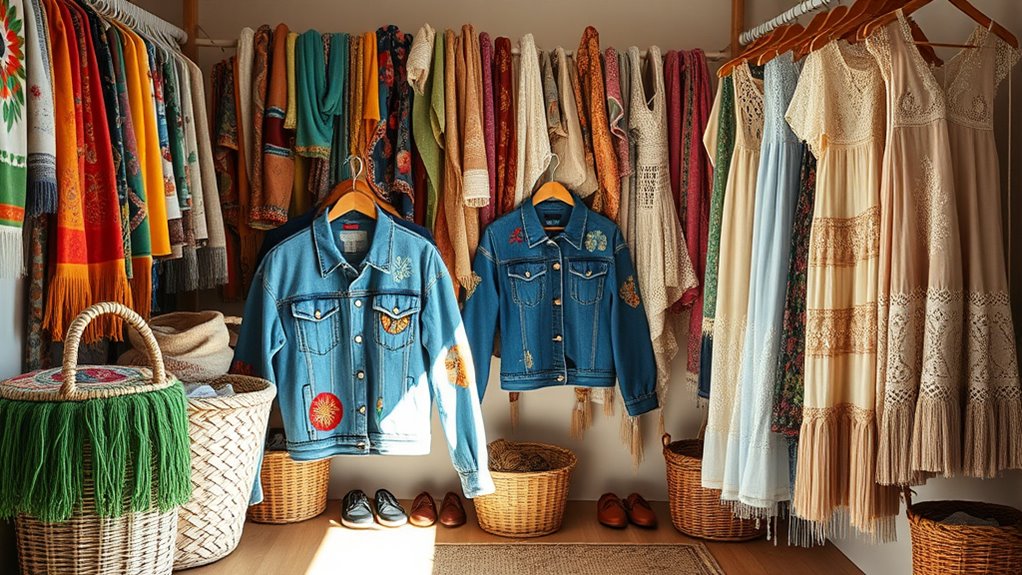
Upcycling offers a creative way to personalize your boho wardrobe while minimizing waste. You can use various upcycling techniques to add embellishments like embroidery, patches, or beads, instantly transforming basic pieces into unique statements. Fabric painting and DIY customization allow you to refresh your garments with vibrant designs or patterns, making each piece one-of-a-kind. Reconfiguring existing clothing—such as turning oversized shirts into crop tops or jeans into shorts—further extends your wardrobe’s versatility. Incorporating recycled materials like vintage fabrics or scrap textiles creates eco-friendly accessories and statement pieces that reflect your personal style. These upcycling techniques not only help you craft a truly personalized boho look but also support sustainable fashion practices by reducing textile waste and promoting eco-conscious choices. Additionally, exploring sustainable fabric options ensures your wardrobe remains eco-friendly and stylish. Understanding the role of tableware in social gatherings can inspire you to create coordinated eco-friendly accessories for your wardrobe and table settings. Engaging with angel numbers can also inspire creative ideas for customizing your wardrobe and accessories, making the process more meaningful. Embracing the importance of eco-conscious choices further enhances your commitment to sustainable fashion while expressing your unique style.
Finding Eco-Friendly Fabrics for Your Boho Outfits
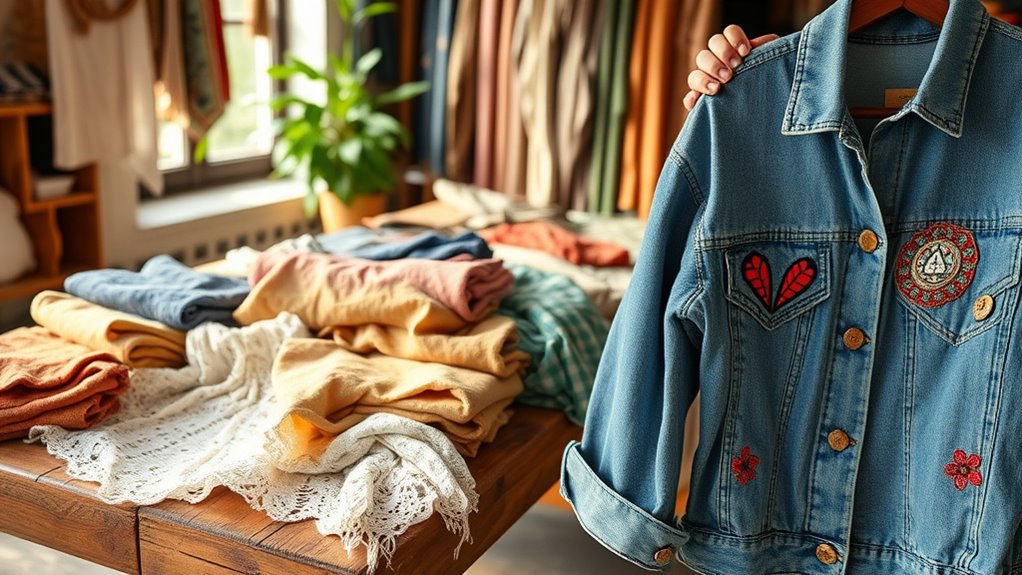
When choosing fabrics for your boho wardrobe, opt for natural and eco-friendly options like organic cotton, hemp, or linen, which are gentle on the environment and comfortable to wear. Recycled materials, such as polyester or nylon made from post-consumer waste, also help reduce textile waste while adding unique pieces to your collection. By prioritizing these fabrics, you can create stylish, sustainable outfits that align with your eco-conscious values. Additionally, selecting sustainable fabric options supports environmentally responsible fashion practices and promotes a healthier planet. Incorporating biodegradable textiles into your wardrobe can further reduce your ecological footprint and contribute to a more sustainable fashion industry. Utilizing sound design techniques can also inspire innovative ways to showcase your sustainable fashion journey through multimedia storytelling. Moreover, choosing fabrics with low environmental impact ensures your wardrobe remains both stylish and eco-friendly.
Organic and Natural Fibers
Choosing eco-friendly fabrics for your boho wardrobe means prioritizing natural, sustainable fibers that are gentle on the environment. Organic cotton is grown without synthetic pesticides, making it breathable and perfect for boho dresses. Hemp requires minimal water and pesticides, ideal for durable pants and jackets. Linen, derived from flax, is biodegradable and needs less water than conventional cotton, perfect for flowy skirts. Tencel, made from sustainably sourced wood pulp, is biodegradable and suited for dresses and skirts. Recycled fabrics like polyester and nylon from post-consumer waste reduce landfill waste and are great for scarves and cardigans. Here’s a quick overview:
| Fiber | Benefits |
|---|---|
| Organic Cotton | Pesticide-free, breathable |
| Hemp | Low water, durable |
| Linen | Biodegradable, lightweight |
| Tencel | Eco-friendly, biodegradable |
| Recycled Fabrics | Reduce waste, versatile |
Additionally, selecting fabrics with certified sustainable sources can further ensure your wardrobe remains eco-friendly and supports environmentally responsible practices. Incorporating sustainable textiles into your wardrobe can also help lower your overall environmental footprint, aligning your fashion choices with your values.
Recycled and Upcycled Materials
Recycled and upcycled materials are transforming the way you can create a sustainable boho wardrobe. Recycled fabrics like recycled polyester and nylon turn post-consumer plastics into eco-friendly fibers, reducing textile waste. Upcycled materials involve repurposing existing garments into unique, stylish pieces, giving new life to thrift store finds. Using natural fibers such as organic cotton, hemp, linen, and Tencel minimizes environmental impact because they require less water and pesticides. Brands committed to sustainable fashion often source these eco-friendly fibers and recycled fabrics, ensuring ethical manufacturing. Incorporating upcycled pieces from thrift stores not only boosts your style but also decreases demand for virgin resources, helping conserve water and reduce chemical use—making your boho wardrobe truly eco-conscious. Additionally, choosing natural fibers over synthetic ones further supports environmental sustainability by lowering microplastic pollution and energy consumption. Embracing sustainable textiles can further enhance your eco-friendly wardrobe by promoting environmentally responsible production practices and supporting recycled fabric initiatives that reduce landfill waste. Moreover, adopting a circular fashion mindset encourages continual reuse and recycling, reducing overall environmental impact.
Must-Know Tips for Upcycling Old Clothes Into Chic Boho Pieces
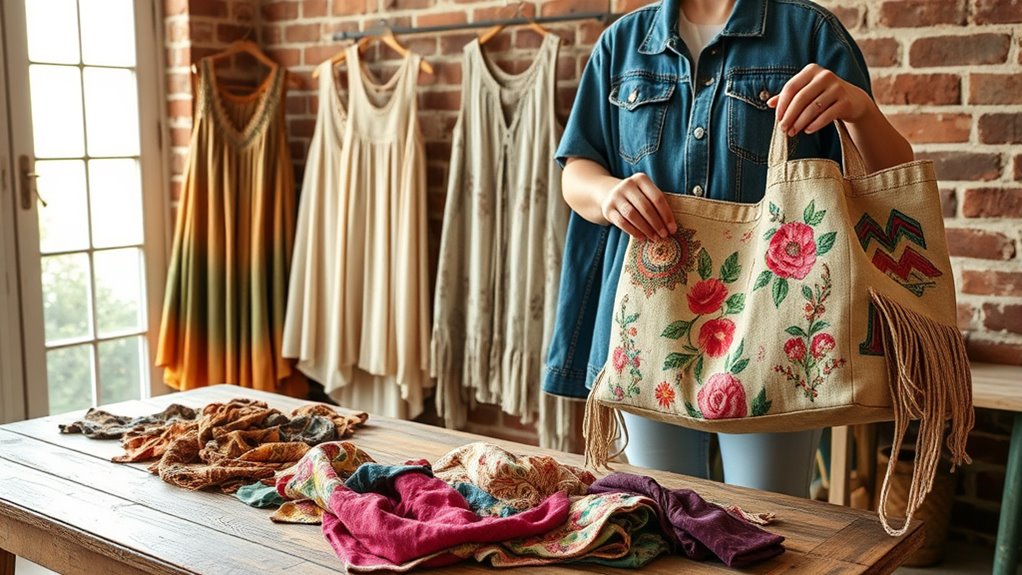
You can transform old clothes into stylish boho pieces with simple alterations and creative embellishments. Cutting, sewing, and adding embroidery or patches instantly give your wardrobe a fresh, personalized look. Try dyeing or repurposing fabric scraps to make unique accessories that complete your eco-friendly boho style. Be mindful of security vulnerabilities in your DIY projects by ensuring safe handling of dyes and sharp tools.
Creative Alteration Ideas
Transforming old clothes into stylish boho pieces is simpler than you might think, especially with a few creative alterations. Upcycling allows you to give vintage garments a fresh look through creative alteration techniques. For example, you can update outdated styles by shortening hemlines or adding flare to sleeves, instantly achieving a boho style. Incorporate patches, embroidery, or beading to add textured, personalized details that elevate your outfit’s charm. Combining fabric scraps into patchwork designs creates a unique vintage transformation that promotes fashion sustainability. Dyes made from natural ingredients like beetroot or turmeric infuse vibrant, eco-friendly colors into plain or worn fabrics. Embracing natural elements in your upcycling process can further enhance the organic, earthy vibe of your boho wardrobe. These simple creative alterations help you craft one-of-a-kind pieces, making your wardrobe both stylish and eco-conscious.
DIY Embellishment Techniques
Embellishing old clothes with DIY techniques is a fantastic way to infuse your wardrobe with unique boho charm. You can enhance upcycled garments using embellishment techniques like hand stitches, fabric dyeing, or fabric painting to create vibrant, one-of-a-kind patterns. Adding patches, appliqués, beads, or embroidery details instantly elevates plain pieces into boho masterpieces. Tassels, fringe, or crochet trims along hems and sleeves amplify the boho aesthetic. Repurposing vintage scarves or lace into collar accents or layered overlays adds vintage flair. Here’s a quick overview:
| Technique | Material/Method | Result |
|---|---|---|
| Fabric dyeing | Tie-dye, batik | Vibrant, unique patterns |
| Embellishments | Patches, appliqués, beads | Personalized, textured look |
| Fabric painting | Stenciling, freehand | Intricate boho-inspired motifs |
Sustainable Accessories to Complete Your Boho Look
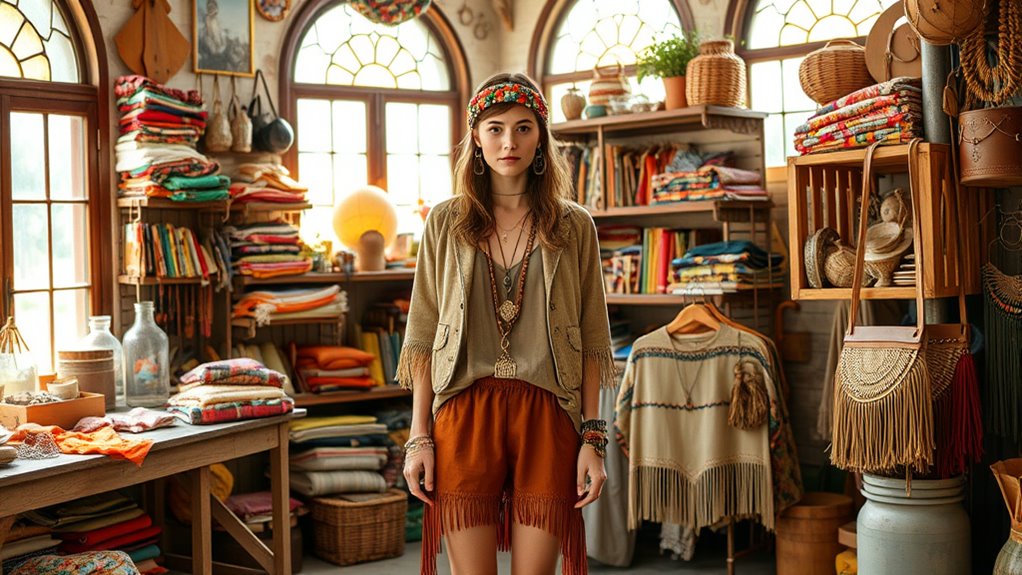
To complete your boho look sustainably, incorporating accessories made from natural, recycled, or upcycled materials is essential. Opt for sustainable accessories crafted from upcycled materials like reclaimed wood, vintage fabrics, or eco-friendly fibers such as hemp and organic cotton. Choosing vegan or upcycled leather accessories, like bags and shoes, helps reduce demand for animal products and environmental harm. Handcrafted accessories made from eco-friendly fibers, including macramé and woven pieces, support fair trade practices and celebrate traditional artisanship. Mixing recycled jewelry with natural-material accessories enhances your boho aesthetic while promoting eco-conscious fashionistas‘ values. Properly caring for these pieces with gentle cleaning extends their lifespan, ensuring your sustainable accessories remain stylish and eco-friendly for years to come.
Caring for and Maintaining Your Eco-Conscious Wardrobe
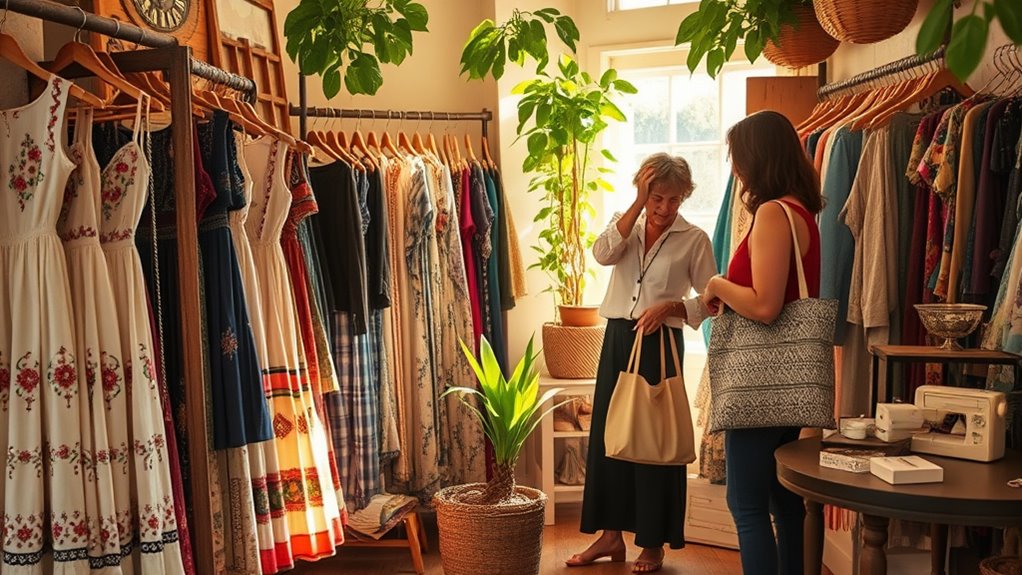
Caring for your eco-conscious wardrobe guarantees your sustainable pieces stay beautiful and last longer. Proper garment care and mindful laundering practices are essential. Use eco-friendly detergents that are free from harsh chemicals to preserve fabric longevity and maintain quality. Always follow the care instructions for each piece, avoiding high heat drying or bleaching, which can damage eco-friendly textiles. Mending and repairs, like sewing loose hems or replacing buttons, prevent unnecessary waste and keep your clothing functional. Properly storing your garments—hanging or folding appropriately—helps prevent damage and preserves their shape. Regular maintenance ensures your wardrobe stays vibrant and durable. Here’s a quick guide to support your sustainable laundry habits:
| Care Step | Benefit |
|---|---|
| Washing sustainable fabrics | Extends lifespan and reduces environmental impact |
| Using eco-friendly detergents | Preserves fabric integrity and supports eco-conscious laundering |
| Proper storage | Maintains shape and prevents damage |
Building a Capsule Wardrobe: Combining Sustainability and Style
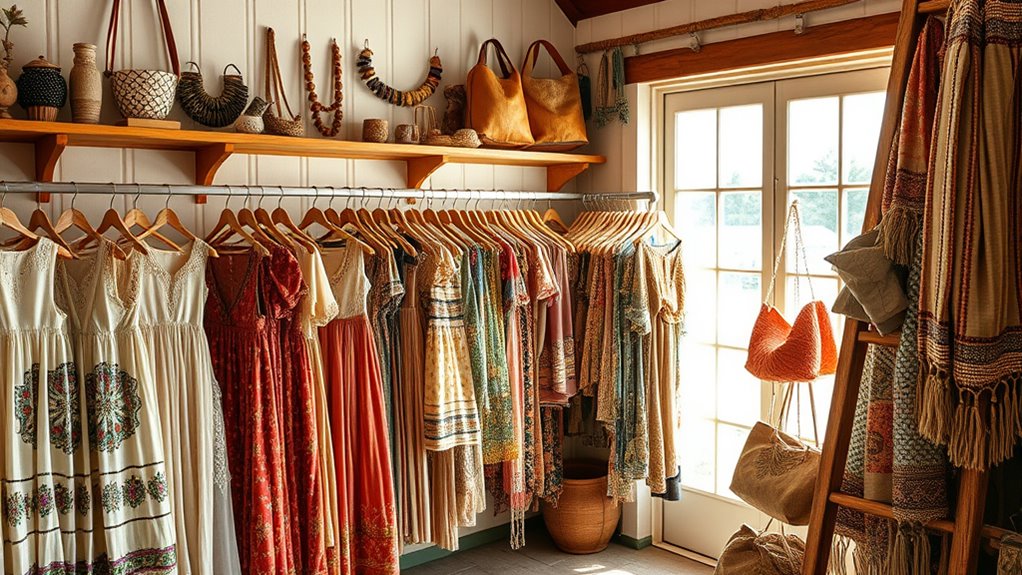
After ensuring your eco-conscious wardrobe stays in top shape, the next step is building a capsule collection that balances sustainability with style. A sustainable capsule wardrobe features versatile pieces made from eco-friendly fabrics like organic cotton, linen, and recycled materials, reducing environmental impact. Thrifting and upcycling are key, allowing you to find vintage, timeless items that support circular fashion while minimizing resource consumption. Incorporate ethically produced garments from brands committed to transparency and fair labor practices to align with ethical fashion values. Focus on selecting high-quality, versatile pieces you love, which can be mixed and matched for countless outfits. Regularly evaluating and rotating your capsule wardrobe helps prevent overconsumption, extends the lifespan of your eco-friendly clothing, and keeps your style fresh and sustainable.
Frequently Asked Questions
How Can I Identify Authentic Vintage Pieces Suitable for a Boho Wardrobe?
When you’re trying to spot authentic vintage pieces for your boho wardrobe, start by examining the fabric and construction. Authentic vintage items often have unique details, like hand-stitched hems or aged patinas. Trust your instincts and look for signs of wear that add character, not damage. Research brands and styles popular in specific eras, and shop at reputable thrift stores or vintage shops where authenticity is more likely.
What Are the Best Eco-Friendly Dyes for Upcycling Clothing?
You might worry about harmful chemicals in dyes, but eco-friendly options make a difference. Look for natural dyes like indigo, madder root, or turmeric, which are biodegradable and non-toxic. These dyes give your upcycled pieces vibrant, authentic color while being gentle on the environment. Using plant-based dyes not only supports sustainability but also adds unique, earthy tones perfect for your boho style.
How Do I Ensure My Thrifted Clothes Fit Perfectly?
To make certain your thrifted clothes fit perfectly, try on everything before buying and visualize potential alterations. Bring a tape measure to check measurements or compare them to your favorite well-fitting pieces. If something’s slightly off, consider simple fixes like hemming or taking in seams. Don’t hesitate to buy clothes that need minor adjustments—you can upcycle them into perfect, unique pieces that reflect your style and fit just right.
What Safety Precautions Should I Take When Upcycling Fabrics?
When upcycling fabrics, you should prioritize safety by working in a well-ventilated space to avoid fumes from dyes or paints. Always wear protective gear like gloves and masks, especially when cutting or handling chemicals. Keep sharp tools away from children, and wash your hands thoroughly afterward. Test any dyes or paints on small fabric samples first to prevent allergic reactions, and follow all manufacturer instructions carefully for safe use.
How Can I Style Sustainable Accessories for a Cohesive Boho Look?
To style sustainable accessories for a cohesive boho look, start by choosing pieces that complement your outfit’s colors and textures. Mix and match natural materials like wood, beads, and recycled metals for an earthy vibe. Layer necklaces, bracelets, and rings to add interest, and don’t be afraid to combine vintage finds with modern pieces. Keep your accessories balanced so they enhance your overall look without feeling overwhelming.
Conclusion
By choosing thrifting, upcycling, and eco-friendly fabrics, you’re weaving a wardrobe that’s as sustainable as it is stylish. Think of your closet as a garden—nurture it with love and creativity, and it’ll bloom with unique, timeless pieces. Every conscious choice you make helps protect the planet while expressing your free-spirited boho vibe. Together, let’s turn your wardrobe into a vibrant tapestry of sustainability and style!
